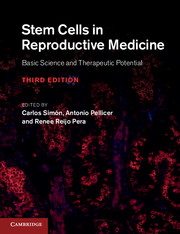
- Publisher:
- Cambridge University Press
- Online publication date:
- July 2013
- Print publication year:
- 2013
- Online ISBN:
- 9781139540742

Stem cell science has the potential to impact human reproductive medicine significantly – cutting edge technologies allow the production and regeneration of viable gametes from human stem cells offering potential to preciously infertile patients. Written by leading experts in the field Stem Cells in Reproductive Medicine brings together chapters on the genetics and epigenetics of both the male and female gametes as well as advice on the production and regeneration of gene cells in men and women, trophoblasts and endometrium from human embryonic and adult stem cells. Although focussing mainly on the practical elements of the use of stem cells in reproductive medicine, the book also contains a section on new developments in stem cell research. The book is essential reading for reproductive medicine clinicians, gynecologists and embryologists who want to keep abreast of practical developments in this rapidly developing field.
 Loading metrics...
Loading metrics...
* Views captured on Cambridge Core between #date#. This data will be updated every 24 hours.
Usage data cannot currently be displayed.